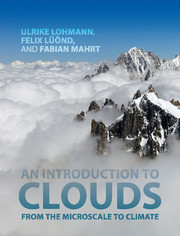Book contents
- Frontmatter
- Dedication
- Contents
- Preface
- List of symbols and acronyms
- 1 Clouds
- 2 Thermodynamics
- 3 Atmospheric dynamics
- 4 Mixing and convection
- 5 Atmospheric aerosol particles
- 6 Cloud droplet formation and Köhler theory
- 7 Microphysical processes in warm clouds
- 8 Microphysical processes in cold clouds
- 9 Precipitation
- 10 Storms and cloud dynamics
- 11 Global energy budget
- 12 Impact of aerosol particles and clouds on climate
- References
- Index
6 - Cloud droplet formation and Köhler theory
Published online by Cambridge University Press: 05 June 2016
- Frontmatter
- Dedication
- Contents
- Preface
- List of symbols and acronyms
- 1 Clouds
- 2 Thermodynamics
- 3 Atmospheric dynamics
- 4 Mixing and convection
- 5 Atmospheric aerosol particles
- 6 Cloud droplet formation and Köhler theory
- 7 Microphysical processes in warm clouds
- 8 Microphysical processes in cold clouds
- 9 Precipitation
- 10 Storms and cloud dynamics
- 11 Global energy budget
- 12 Impact of aerosol particles and clouds on climate
- References
- Index
Summary
In this chapter the details of phase transitions, nucleation and cloud droplet formation are discussed. Some phase transitions require a nucleation process, for instance, ice nucleation or the gas-to-particle conversion of aerosol particles. Other phase transitions, such as cloud droplet formation, do not require a nucleation process: cloud droplets form on soluble or hydrophilic aerosol particles such as sulfate, sea salt (soluble) and mineral dust (hydrophilic) particles. These particles acquire water by condensation and hence develop a liquid phase at conditions where the nucleation of pure water droplets from vapor cannot occur. Although no nucleation process initiates the existence of a cloud droplet, the concept of nucleation is a prerequisite for the understanding of cloud droplet formation and is therefore introduced in Section 6.1. The mathematical formulation of nucleation leads to the Kelvin equation (Section 6.2). Hygroscopic growth (Section 6.3) and Raoult's law (Section 6.4) consider the contribution of aerosol particles to cloud droplet formation. Combining Raoult's law with Kelvin's equation yields the Köhler theory describing the activation of a deliquesced aerosol particle – forming an aqueous solution droplet – into a cloud droplet (Section 6.5). The chapter ends with a discussion of measurements on cloud condensation nuclei (CCN), the subset of aerosol particles that can be activated into cloud droplets (Section 6.6).
Nucleation
From thermodynamics of phase transitions (Chapter 2), we do not obtain information about how a new phase is initiated. One possibility for the initiation of a new phase is a nucleation process; nucleation denotes a phase transition where a cluster of a thermodynamically stable phase forms and grows within the surrounding metastable parent phase. In the case of aerosol nucleation this refers to the formation of a liquid phase out of the gas phase. Ice crystal formation requires the initiation of the ice phase within the liquid or vapor phase.
The nucleation of a new phase requires the parent phase to be in a metastable state, which can be a supersaturated vapor or a supercooled liquid in the atmospheric context. The transition to the new, stable, phase is not spontaneous but is inhibited by an intermediate maximum in the Gibbs free energy, a so-called energy barrier. This energy barrier is of crucial importance, as it governs the kinetics and therefore the likelihood of a specific nucleation process under given atmospheric conditions.
- Type
- Chapter
- Information
- An Introduction to CloudsFrom the Microscale to Climate, pp. 155 - 185Publisher: Cambridge University PressPrint publication year: 2016



